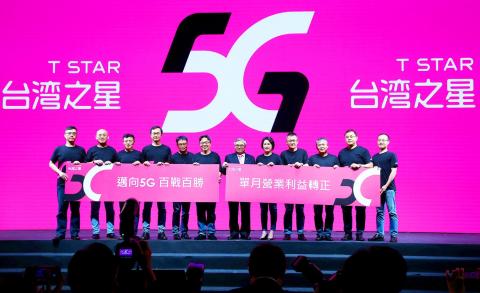Taiwan Star Telecom Co (台灣之星) yesterday launched a rate plan for 4G subscribers to try its 5G technology at less than half the price of similar trial packages offered by the nation’s three biggest telecoms, signaling the possible start of a 5G price war.
With its new “early bird” packages, Taiwan Star offers subscribers two-year, 4G rate plans of at least NT$599 (US$19.94) with unlimited data that are to upgrade to 5G once services launch.
Subscribers can start the trial plan now or withhold the package until the commercial launch of 5G services in the fourth quarter, Taiwan Star said.

Photo: CNA
The NT$599 plan was first launched in Taiwan in 2014, when Taiwan Star entered the telecom market and began rolling out unconventional rate plans to sabotage the pricing schemes of the nation’s three largest telecoms.
With the new packages, it has lowered the threshold for 5G trial plans.
The nation’s major telecoms, led by Chunghwa Telecom Co (中華電信), require users to sign up for a monthly plan of at least NT$1,399 for a free upgrade to 5G services later this year.
“There is a 50 percent chance that the price competition [will continue with 5G services],” Taiwan Star president Cliff Lai (賴弦五) told reporters. “The big telecoms are the key… We are not the price-setter in Taiwan’s telecom market.”
He urged local rivals to forgo the price war, given high 5G spectrum prices and deployment costs, and declined to comment on a NT$1,300 monthly rate proposed by the National Communications Commission.
Looking at countries that have launched 5G services, the rate plans are usually 20 to 40 percent more expensive than their 4G predecessors, Lai said.
With its “early bird” plans, Taiwan Star aims to expand its subscriber base from 2.35 million to 2.5 million users by the end of this year, he said.
Taiwan Star aims to generate more free cash from its operations to fund the construction of its 5G infrastructure and daily operations for two years after the commercial launch of 5G, he added.
Taiwan Star reported minus-NT$1.8 billion in free cash flow last year.
The company last month won 40 megahertz (MHz) of 5G spectrum in the 3.5 gigahertz frequency band at an auction for NT$19.71 billion.
Taiwan Star said that it is open to sharing spectrum with any established telecoms.
Taiwan Mobile Co (台灣大哥大), which secured the least amount of 5G spectrum — 60MHz — among the big three, is widely seen as a potential partner for Taiwan Star, which was tight-lipped about any talks about partnerships.
To finance the 5G deployment, Taiwan Star’s board of directors has approved raising NT$16 billion via three private placements.

Stephen Garrett, a 27-year-old graduate student, always thought he would study in China, but first the country’s restrictive COVID-19 policies made it nearly impossible and now he has other concerns. The cost is one deterrent, but Garrett is more worried about restrictions on academic freedom and the personal risk of being stranded in China. He is not alone. Only about 700 American students are studying at Chinese universities, down from a peak of nearly 25,000 a decade ago, while there are nearly 300,000 Chinese students at US schools. Some young Americans are discouraged from investing their time in China by what they see

Taiwan Transport and Storage Corp (TTS, 台灣通運倉儲) yesterday unveiled its first electric tractor unit — manufactured by Volvo Trucks — in a ceremony in Taipei, and said the unit would soon be used to transport cement produced by Taiwan Cement Corp (TCC, 台灣水泥). Both TTS and TCC belong to TCC International Holdings Ltd (台泥國際集團). With the electric tractor unit, the Taipei-based cement firm would become the first in Taiwan to use electric vehicles to transport construction materials. TTS chairman Koo Kung-yi (辜公怡), Volvo Trucks vice president of sales and marketing Johan Selven, TCC president Roman Cheng (程耀輝) and Taikoo Motors Group

MAJOR DROP: CEO Tim Cook, who is visiting Hanoi, pledged the firm was committed to Vietnam after its smartphone shipments declined 9.6% annually in the first quarter Apple Inc yesterday said it would increase spending on suppliers in Vietnam, a key production hub, as CEO Tim Cook arrived in the country for a two-day visit. The iPhone maker announced the news in a statement on its Web site, but gave no details of how much it would spend or where the money would go. Cook is expected to meet programmers, content creators and students during his visit, online newspaper VnExpress reported. The visit comes as US President Joe Biden’s administration seeks to ramp up Vietnam’s role in the global tech supply chain to reduce the US’ dependence on China. Images on

New apartments in Taiwan’s major cities are getting smaller, while old apartments are increasingly occupied by older people, many of whom live alone, government data showed. The phenomenon has to do with sharpening unaffordable property prices and an aging population, property brokers said. Apartments with one bedroom that are two years old or older have gained a noticeable presence in the nation’s six special municipalities as well as Hsinchu county and city in the past five years, Evertrust Rehouse Co (永慶房產集團) found, citing data from the government’s real-price transaction platform. In Taipei, apartments with one bedroom accounted for 19 percent of deals last